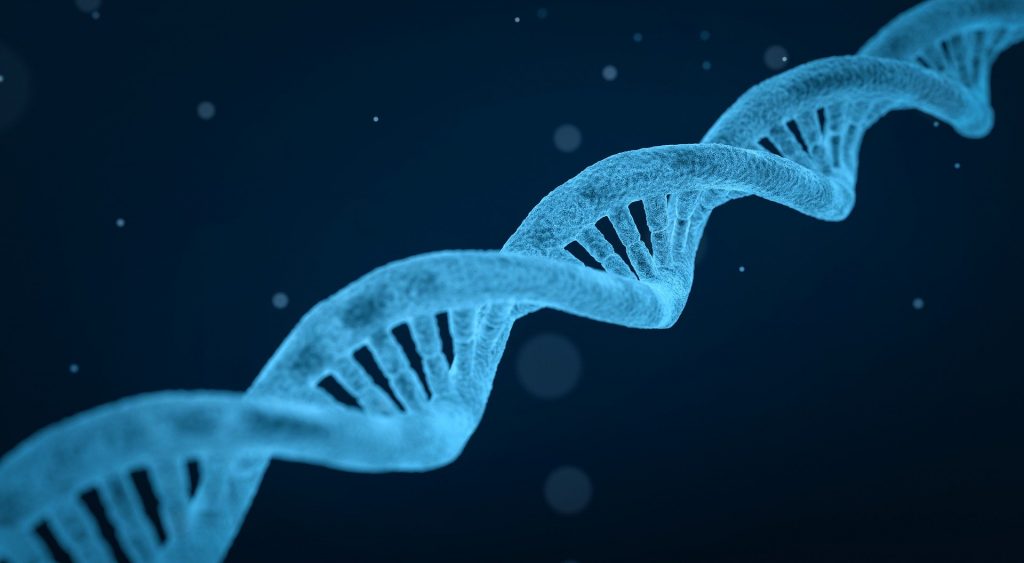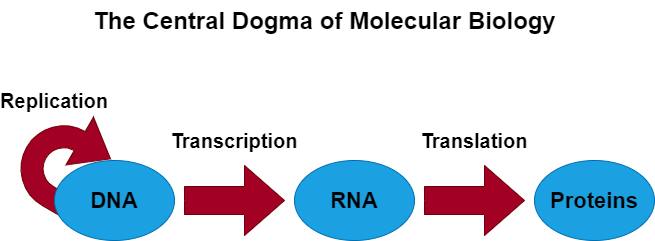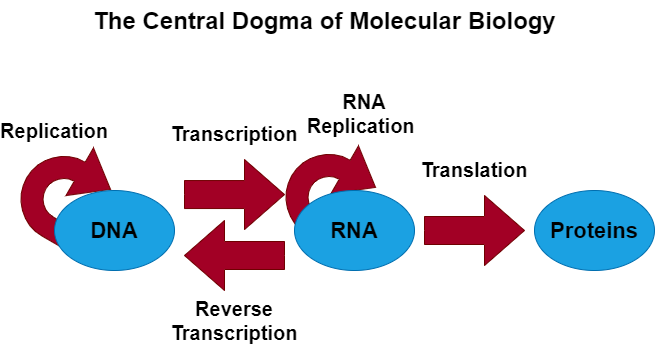DNA or Deoxyribonucleic acid is the genetic material of all the cells and most viruses, with the exception of some viruses that use another type of nucleic acid, called RNA or Ribonucleic acid. As we will see in the following posts, DNA presents some characteristics that make it the ideal molecule to carry out the functions of the genetic material of all living things. But what is the genetic material, and what does it do inside the cells?

Genetic material functions
The genetic material contains the information that determines our characteristics, either external, physical characteristics such as the color of our hair, eyes, and skin or the invisible functions that take place inside our cells to keep our bodies up and running. In order to achieve that, DNA must be a very stable molecule that stores the genetic information inside each of our cells. When our cells divide, the daughter cells must also acquire the same genetic information that was present in the parent cells. This means that the genetic material has to be transferred to the newly formed cells without changes or with the fewest changes possible. The genetic material also has to be passed down from parent to offspring in a specific way. When the sperm fertilizes the egg, the zygote that’s formed must contain the appropriate quantity of DNA to give rise to a healthy baby. This requires half of the genetic information of the father and the other half of the genetic information of the mother to combine and create a new organism.
Even though many of our cells are often renewed inside our bodies, the genetic information must remain stable and intact, as we mentioned before. This means that when the DNA is replicated inside a cell to make copies of itself intended for the daughter cells, it must do so with great precision. Although this is the case, there are times when this process fails and errors occur in the DNA during replication. These errors alter the information that is carried by the genetic material and might cause a problem in the functioning of the organism. These changes are called mutations, but we will not discuss this term or its consequences any further for now.
Another very important function that the genetic material is responsible for is that it carries the instructions for the synthesis of proteins. Proteins are crucial macromolecules taking part in the structuring and functioning of the cells and many more things inside our bodies. This is because they have a very broad range of properties. The parts of the DNA that contain the information for protein synthesis are called genes. Keep in mind that there are also genes that do not code for proteins, but we will only talk about the protein-coding genes in this post. Different genes code for different proteins. For example, there is not one single gene that codes for both hemoglobin, the oxygen transferring protein of our red blood cells, and insulin, the hormone that’s produced by the pancreas and regulates blood glucose levels.
Some interesting facts
The DNA of different species presents a lot of differences that reflect on their appearance but also their internal structure and ways of operation. If we take evolution into account, closely related species have many similarities in their genetic material. For example, we share 99% of our DNA with the chimpanzee, our, what seems to be, closest relative. However, there are more similarities than you could imagine, even among unrelated organisms. For example, the banana DNA is more than 60% identical to the human DNA even though bananas look nothing like us. If we compare individuals of the same species, the shared percentage of DNA is even greater. Two non-related humans, despite the distinct features of their appearance, share 99.9% of their DNA. What is the reason behind all these unexpected similarities? All of the organisms on our planet, whether they are still alive or have gone extinct, have something in common. They emerged from the same ancestor, the Last Universal Common Ancestor (LUCA) that evolved in the variety of species that have at some point inhabited the Earth, and therefore, share many parts of their genetic material. Some of these parts contain the instructions for fundamental cellular functions that need to remain unaltered in all the organisms despite other differences. Otherwise, the organism won’t function the way it should. This means that at a molecular level, all the living things have much more in common even if they do not look the same.
All of the cells of an organism possess the same DNA. But the proteins that are produced are not the same in all of the cells, and that is because different types of cells need different proteins to carry out their functions. For example, the gene containing the information for the production of insulin is present in all of the cells of our bodies. But insulin is only needed in a specific type of pancreatic cells. The cells of, let’s say, the heart, do not need insulin because they have different roles in the body. Therefore, the insulin gene does not code for the synthesis of insulin in the heart. We can make two conclusions from the above examples. The genotype, which is the complete set of genes of the DNA, is the same in all of the cells of the same body. The phenotype, on the other hand, which describes an organism’s characteristics or traits, either observable or not, is not the same when we compare different types of cells of the same body.
The central dogma of molecular biology
We already know that in eukaryotic cells, DNA is kept inside the nucleus, while in prokaryotic cells, where there is no nucleus, DNA is located in a cytoplasmic region, called the nucleoid. Regardless of the type of cell and the location of the genetic material, we know that the DNA does not move to instruct the protein synthesis, which takes place in the ribosomes. Therefore, there is a molecule that acts as an intermediate message between DNA and proteins. This is RNA, and more specifically, messenger RNA or mRNA, which is produced by transcription. Transcription is a process during which the genetic information flows from DNA to mRNA. More specifically, the gene that codes for a protein that is needed in the cell is transcribed, and the information is converted to the form of mRNA.
Transcription occurs in the cytoplasm in prokaryotes but inside the nucleus in eukaryotes. In the latter case, the mRNA has to be transported from the nucleus to the cytoplasm and especially to the ribosomes for translation to start. Translation is the process of protein synthesis during which the information that is carried by the mRNA is used for the assembly of amino acids in a polypeptide chain. The gene’s nucleotide sequence determines the nucleotide sequence of the mRNA. Afterward, the mRNA sequence determines the sequence of amino acids according to the genetic code, a code that matches nucleotides with amino acids. All of this ensures that the information will be passed down from DNA to proteins without changes. The amino acid sequence determines the protein’s structure and function. Therefore, different genes code for different proteins that serve different functions.
The central dogma of molecular biology was introduced by Francis Crick in 1958 and referred to the flow of genetic information from one molecule to the other. More precisely, Crick showed that the information flows from DNA to RNA through transcription and then to proteins through translation. Additionally, DNA can self-replicate during the process of replication.

The central dogma of molecular biology now includes some variations. For example, some RNA viruses have the ability to replicate their RNA, while we previously thought this property was exclusive to DNA. Other viruses can use an enzyme that transcribes the RNA to DNA in a process called reverse transcription because it follows the opposite direction. Instead of going from DNA to RNA, it goes from RNA to DNA. But these last two cases are only exceptions to the rule that applies to all of the living organisms, no matter if they are eukaryotic or prokaryotic.

